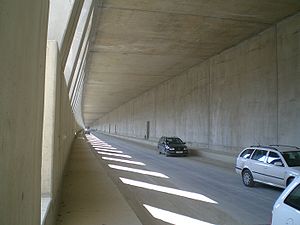- New Lower Inn Valley railway
-
This article is about the high-speed line of the Lower Inn Valley railway. For the existing line, see Lower Inn Valley railway.
New Lower Inn Valley railway Concrete shell for the new lineLine length: 40,236 Gauge: 1435 Voltage: 15 kV, 16,7 Hz AC Maximum speed: 250 Legend
Planned railway from Brannenburg 
Existing line from Kufstein 
Schaftenau junction 
Existing line from Wörgl 








Inn 

Existing line from Wörgl 
24,262 Wörgl 2 junction Radfeld interconnection 
Existing line to Jenbach 
26,500 Radfeld cutting (L 790 m) 
27,290 Radfeld–Wiesing tunnel (L 11.507 m) 
Inn 
Existing line 
38,797 Wiesing–Jenbach Tunnel (L 4.473 m) 
Existing line 

43,270 Jenbach cutting (L 620 m) 
Existing line from Jenbach 
43,890 Jenbach 2 junction Stans interconnection 
Existing line to Fritzens-Wattens 1 junction 
44,760 Stans cutting (L 525 m) 
45,285 Stans–Terfens tunnel (L 10.570 m) 
Existing line 
Passing tracks 
55,855 Fritzens gallery (L 1.330 m) 
57,185 Fritzens–Baumkirchen tunnel (L 3.940 m) 
Existing line 

61,125 Baumkirchen cutting (L 624 m) 
Existing line from Jenbach 2 junction 
61,749 Fritzens-Wattens 1 junction Baumkirchen interconnection 
Existing line to Innsbruck 
Innsbruck bypass to Innsbruck 1 junction The New Lower Inn Valley railway (German: Neue Unterinntalbahn) is a 40 kilometre-long double-track high-speed main line of the Austrian railways currently under construction. It will connect the Brenner railway at Innsbruck and the Innsbruck bypass with the line to Kufstein, connecting with Germany, Salzburg and eastern Austria. It will form a part the core of the network of Austrian Federal Railways (ÖBB). The bypass is part of the Line 1 of Trans-European Transport Networks (TEN-T). After its completion in 2012, it will relieve the existing Lower Inn Valley railway between Wörgl and Baumkirchen with trains able to operate at up to 250 km/h.[1] It will be electrified at 15 kV, 16.7 Hz.
Contents
History
Section 1: Kundl-Baumkirchen
The Kundl–Baumkirchen section is currently under construction and scheduled for commissioning in 2012. The line will be 40 km-long line, of which approximately 32 km will be in tunnels.
From Kundl station out the existing line will be supplemented by a high-speed lines and will form a four-track line from an grade-separated junction at Radfeld. The new segment then descends between the tracks of the existing line and runs to the 11.5 kilometre-long Radfeld–Wiesing tunnel. After passing under the Inn it continues through the 4.5 kilometre-long Wiesing-Jenbach tunnel, passing under Jenbach railway station to the grade-separated junction at Stans. The line descends again, and continues through the 10.5 kilometre-long Stans-Terfens tunnel. In the tunnel there is a third track to allow overtaking movements, thus increasing line capacity. The route then goes through the 1.3 kilometre-long Terfens gallery and runs parallel to the existing line. It then runs into a tunnel under the Fritzens-Wattens station to join the old line at Baumkirchen where it separates towards Brenner/Verona via the Innsbruck bypass or towards Innsbruck/Arlberg via the existing line.[2]
Section 2: Brannenburg-Kundl
The approximately 25 kilometre-long section from Brannenburg-Kundl is currently in the planning phase with route selection between Schaftenau and Kundl has been completed. The continuation of the route into Germany is currently being negotiated.[3]
The selected route south from Schaftenau would leave the existing line via several short tunnels and cuttings to join the route of the A12 autobahn. It would then run through a nearly 10 kilometre-long tunnel under the mountains of the southern Angerbergs and under the Inn, the A12 and the built-up areas of Kundl before emerging between the tracks of the existing line and running to the grade-separated junction at Radfeld.[4]
Signalling
The new line will be fitted with ETCS Level 2 signalling system.[1] Four new electronic interlocking systems are being built to control both the new line and the existing line. These systems will be controlled from the new Innsbruck operations control centre (German: Betriebsfernsteuerzentrale), which is currently under construction.
References
- ^ a b "Die Neue Unterinntalbahn (The new Lower Inn railway)" (in German) (PDF). Brenner Eisenbahn GmbH. http://www.beg.co.at/fileadmin/downloads/Beg_AMA.pdf. Retrieved 13 February 2010.
- ^ "Section 1 route map" (in German) (PDF). Brenner Eisenbahn GmbH. http://www.beg.co.at/fileadmin/downloads/Trassenplan_07.pdf. Retrieved 13 February 2010.
- ^ "Trassenauswahlverfahren für zweiten Abschnitt der neuen Unterinntalbahn abgeschlossen (Route selection process for the second section of the new Lower Inn Valley railway completed)" (in German). Austrian Federal Railways. http://www.unterinntalbahn.at/news-presse/presseservice/aktuell/presseberichte/trassenauswahlverfahren-fuer-zweiten-abschnitt-der-neuen-unterinntalbahn-abgeschlossen-170909/. Retrieved 13 February 2010.
- ^ "Section 2 route map" (in German) (PDF). Brenner Eisenbahn GmbH. http://www.beg.co.at/fileadmin/2.Abschnitt/TrassenauswahlN1g.jpg. Retrieved 13 February 2010.
Berlin–Halle · Halle/Leipzig–Erfurt · Erfurt–Nuremberg · Nuremberg–Munich · Munich–Rosenheim · Rosenheim–Kufstein · Kufstein–Wörgl · Wörgl–Innsbruck · Innsbruck bypass · Innsbruck–Franzensfeste (Brenner Base Tunnel) · Franzensfeste–Verona · Milan/Verona–Bologna · Bologna–Florence · Florence–Rome · Rome–Naples · Naples–Salerno · Salerno–Reggio Calabria(it) · Strait of Messina Bridge · Messina–Palermo(de) ·
Categories:- High-speed railway lines in Austria
Wikimedia Foundation. 2010.

